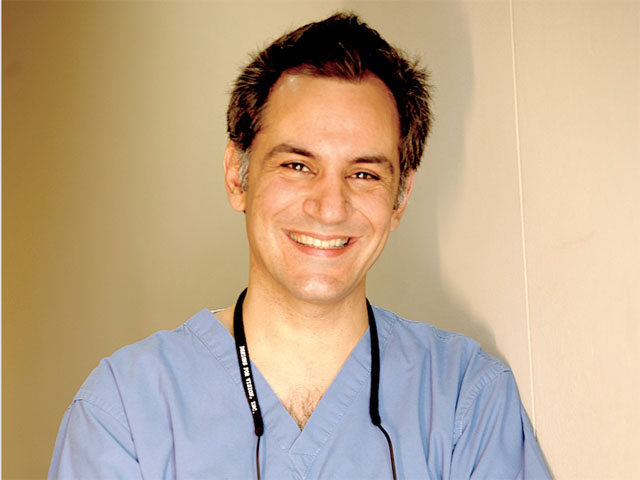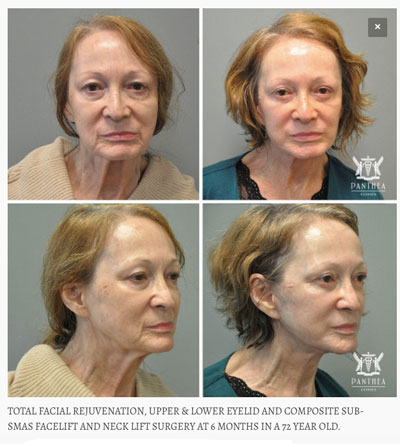Everything you need to know before considering facelift surgery.

Everything You Need To Know Before Considering Facelift Surgery
World renowned Australian plastic surgeon shares what you need to know before, during and after facelift surgery.
The face is one of the most intricate parts of the body and its importance in projecting our sense of 'self' is clear. Performing facelift surgery is often thought of as a subspecialty amongst plastic surgeons and those who are interested seek further training beyond basic plastic surgical qualifications. Dr Farhadieh has an interest in facial surgery and has undertaken two separate clinical fellowships in London, England, focusing on the face from both cosmetic and reconstructive perspectives.
1. Some form of Superfical Musculo-Aponeurotic System(SMAS) based surgery is needed to achieve durable and natural results. Long-term results that maintain shape and harmony are only possible if an appropriate SMAS -based technique is used.
The advantage of this technique is as the name suggests, the short scar that doesn't extend into the hairline either in the temples or at the back. The risk to facial nerve should be minimal in expert hands. Some of the largest series of facelift surgery internationally show 1% risk of permanent facial nerve damage. Temporary facial nerve paresis is not uncommon in any SMAS -based procedure as the nerve often undergoes traction. These often recover within 8 to 12 weeks at the latest.
2. You will need to stay in hospital overnight. Immediately after surgery you will see the incisions, but the incisions are placed in such a way that once healed they will not be visible or noticed. From time to time, scar abnormalities or some skin loss might occur as a result of surgery. These can be managed conservatively, occasionally requiring secondary surgery.
3. Bruising and swelling can take 7 to 10 days to settle. The remainder of the swelling slowly subsides over the ensuing weeks. By 12 weeks all swelling should have completely subsided.
4. Numbness of the area is common.
What's important is to recognise unless there is any major nerve damage, this will improve over the ensuing months. Whilst the vast majority patients report near-normal sensations at three months, almost all patients report normal sensation in the areas of surgery at 12 months. The most common sensory nerve damage during surgery is the greater regular nerve where patients often complain of numbness in the earlobe which is permanent unless the nerve is repaired.
 5. Sleeping Position
5. Sleeping Position
During the immediate post-operative period, sleep at an incline in bed at 30°. Do not sleep on the side of the face, and avoiding straining and coughing as it helps reduce the chance of swelling or any bleeding.
6. Although all humans have some intrinsic asymmetry to their face and body, in adequately trained hands noticeable persistent postoperative asymmetry is rare. Occasionally the facial nerve is bruised during surgery, but this tends to recover within a matter of weeks.
What are the risks?
Our face forms such a pivotal part of our sense of self that when considering any surgery, it is only natural to be concerned about the possible complications. Facelift surgery is performed routinely by facial aesthetic trained plastic surgeons. Given the intricacy of the anatomy and the vital requirements for meticulous surgery in close proximity to the facial nerve, the risk profile of the surgery often involves the surrounding anatomical structures.
Large-scale studies indicate that up to 1% of patients suffer irreversible damage to professional branches. Between 1 to 5% of patients end up with post-operative haematoma or bleeding which often happens within the first 24 hours requiring surgery for evacuation. Minor complications such as wound dehiscence and skin loss are more common in patients who smoke. These form some of the main complications associated with facelift surgery.
Where manipulation of the Superfical Musculo-Aponeurotic System(SMAS)layer using one of a multitude of facelift surgery is undertaken, the risks to the facial nerve are higher. Improved knowledge of the anatomy of the small branches of the facial nerve in the face over the last 40 years has made the surgery safer. However, in the small group of patients wind up with facial nerve injury as a result of facelift surgery, the options involve symmetrisation using muscle paralysing agents on the opposite side. This allows balancing of the face as after all it is symmetry that in large determines the ultimate outcome of facial rejuvenation surgery.
https://www.panthea.com.au/
The face is one of the most intricate parts of the body and its importance in projecting our sense of 'self' is clear. Performing facelift surgery is often thought of as a subspecialty amongst plastic surgeons and those who are interested seek further training beyond basic plastic surgical qualifications. Dr Farhadieh has an interest in facial surgery and has undertaken two separate clinical fellowships in London, England, focusing on the face from both cosmetic and reconstructive perspectives.
1. Some form of Superfical Musculo-Aponeurotic System(SMAS) based surgery is needed to achieve durable and natural results. Long-term results that maintain shape and harmony are only possible if an appropriate SMAS -based technique is used.
The advantage of this technique is as the name suggests, the short scar that doesn't extend into the hairline either in the temples or at the back. The risk to facial nerve should be minimal in expert hands. Some of the largest series of facelift surgery internationally show 1% risk of permanent facial nerve damage. Temporary facial nerve paresis is not uncommon in any SMAS -based procedure as the nerve often undergoes traction. These often recover within 8 to 12 weeks at the latest.
2. You will need to stay in hospital overnight. Immediately after surgery you will see the incisions, but the incisions are placed in such a way that once healed they will not be visible or noticed. From time to time, scar abnormalities or some skin loss might occur as a result of surgery. These can be managed conservatively, occasionally requiring secondary surgery.
3. Bruising and swelling can take 7 to 10 days to settle. The remainder of the swelling slowly subsides over the ensuing weeks. By 12 weeks all swelling should have completely subsided.
4. Numbness of the area is common.
What's important is to recognise unless there is any major nerve damage, this will improve over the ensuing months. Whilst the vast majority patients report near-normal sensations at three months, almost all patients report normal sensation in the areas of surgery at 12 months. The most common sensory nerve damage during surgery is the greater regular nerve where patients often complain of numbness in the earlobe which is permanent unless the nerve is repaired.
 5. Sleeping Position
5. Sleeping Position During the immediate post-operative period, sleep at an incline in bed at 30°. Do not sleep on the side of the face, and avoiding straining and coughing as it helps reduce the chance of swelling or any bleeding.
6. Although all humans have some intrinsic asymmetry to their face and body, in adequately trained hands noticeable persistent postoperative asymmetry is rare. Occasionally the facial nerve is bruised during surgery, but this tends to recover within a matter of weeks.
What are the risks?
Our face forms such a pivotal part of our sense of self that when considering any surgery, it is only natural to be concerned about the possible complications. Facelift surgery is performed routinely by facial aesthetic trained plastic surgeons. Given the intricacy of the anatomy and the vital requirements for meticulous surgery in close proximity to the facial nerve, the risk profile of the surgery often involves the surrounding anatomical structures.
Large-scale studies indicate that up to 1% of patients suffer irreversible damage to professional branches. Between 1 to 5% of patients end up with post-operative haematoma or bleeding which often happens within the first 24 hours requiring surgery for evacuation. Minor complications such as wound dehiscence and skin loss are more common in patients who smoke. These form some of the main complications associated with facelift surgery.
Where manipulation of the Superfical Musculo-Aponeurotic System(SMAS)layer using one of a multitude of facelift surgery is undertaken, the risks to the facial nerve are higher. Improved knowledge of the anatomy of the small branches of the facial nerve in the face over the last 40 years has made the surgery safer. However, in the small group of patients wind up with facial nerve injury as a result of facelift surgery, the options involve symmetrisation using muscle paralysing agents on the opposite side. This allows balancing of the face as after all it is symmetry that in large determines the ultimate outcome of facial rejuvenation surgery.
https://www.panthea.com.au/
MORE



